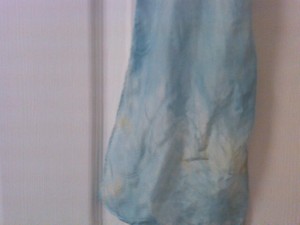My husband has nicknamed treadles the gas pedals. He is not far off. Treadles do have an important function in weaving. They enable a weaver to create patterns in the weaving. As I said for the backstrap loom, the weaver picks up the individual threads. Treadles remove this step (no pun intended). The weaver steps on the appropriate treadle, which picks up the threads that the weaver has tied on to the metal rings. As these threads are lifted, the pattern is created. This enables the weaver, in combination with the threading through the reed and heddles, to make patterns, and, even for a four shed loom, fairly complicated ones.
Usually, the pattern is repeated across the warp.Look at an antique coverlet and you will see what I mean.
Since I have a four shed loom, I mainly use four treadles.
Treadles are one of THE Main features of modern looms. According to Broudy, the treadles appeared in Europe about 1000 AD. The loom frame was not far behind. And, by the time silk reached Europe, weaving was already a highly developed art. Looms and weaving patterns developed in response to the fiber used and whether tapestries or other elaborate weaving would be done. Flax, although hard to process into linen, has smooth non-sticky fibers that lie together. Wool is a more forgiving fiber and takes dyes well. Silk is different from both. But whatever the fiber, and however the threads are warped and threaded, the treadles make the weaving of a pattern much easier than picking each strand up by hand.


